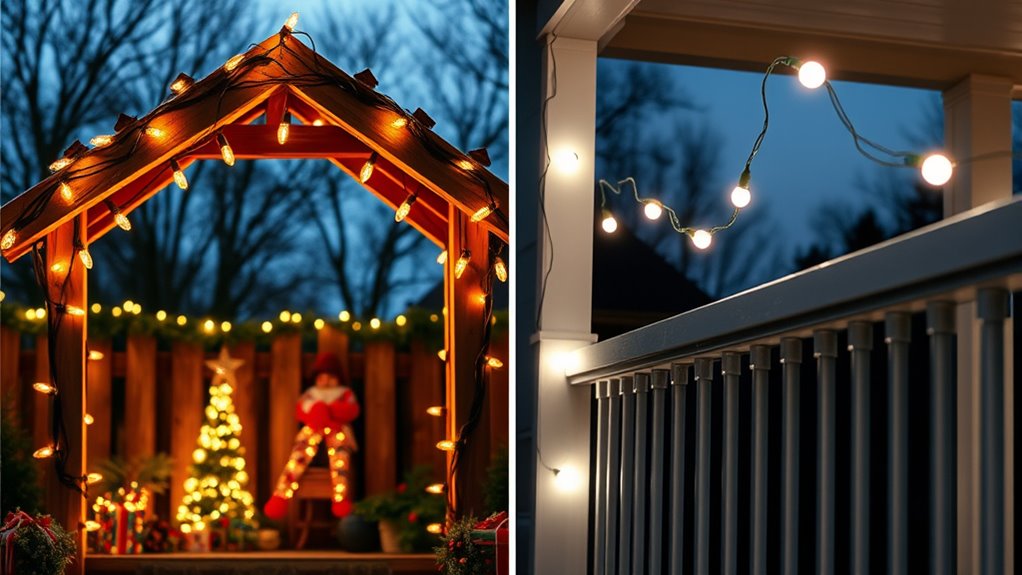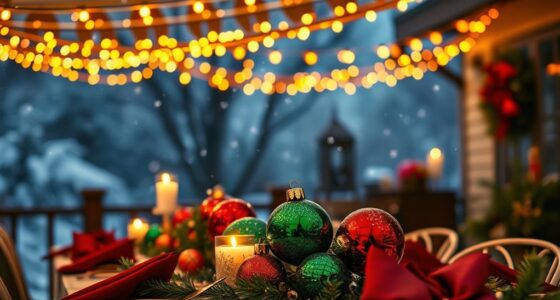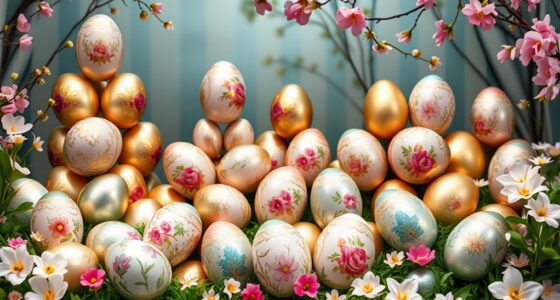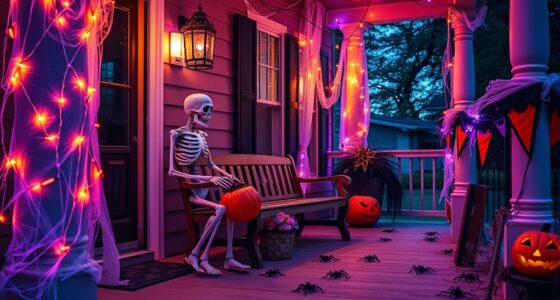When choosing between DIY and store-bought Christmas lights, safety and cost are key. DIY setups might save money upfront but can pose risks if wiring isn’t secure or components aren’t certified, increasing fire or shock hazards. Store-bought lights are tested for safety and last longer, making them a more reliable choice even if they cost more initially. To find out how each option performed and which is safer and more cost-effective, keep exploring the details.
Key Takeaways
- Store-bought lights are safer, certified, and designed for durability, reducing the risk of electrical hazards during holiday decorating.
- DIY lights can be cost-effective initially but may lead to higher expenses due to frequent repairs and replacements.
- Commercial lights offer consistent brightness and appearance, enhancing the overall aesthetic compared to DIY setups.
- DIY projects often lack safety certifications, increasing potential fire and shock risks if not properly assembled.
- Long-term, store-bought lights tend to be more reliable and cost-efficient, making them a better choice for festive displays.
Safety and Cost Considerations in Christmas Lighting

When it comes to decorating your home for Christmas, choosing between DIY and store-bought lights is a decision that can impact your holiday experience. You need to weigh safety considerations and cost analysis to make the best choice. DIY lights can be charming and personalized, but they often require more effort and come with safety risks if not assembled correctly. Store-bought options, on the other hand, are designed with safety standards in mind and often come ready to use, reducing the risk of electrical hazards.
Safety considerations should be your top priority. With DIY lights, you’re responsible for ensuring all wiring is insulated properly, connections are secure, and that you don’t overload circuits. Poorly assembled DIY lights can pose fire hazards or cause electrical shocks, especially if you’re using old or incompatible components. Store-bought lights are tested to meet safety regulations, which gives you peace of mind. They typically feature UL listing or similar certifications, ensuring they’re safe for indoor or outdoor use. While DIY options might seem more authentic or creative, neglecting safety standards can turn your festive project into a hazard.
Cost analysis is another critical factor. DIY lights often seem cheaper initially because you can repurpose old bulbs, wires, and decorations you already own. However, when you add up the costs of purchasing new components like extension cords, adapters, or special sockets, the expenses can quickly climb. Additionally, if your DIY setup doesn’t last or fails prematurely, you may need to replace it, increasing costs overall. Store-bought lights tend to be more expensive upfront, but they’re designed for durability and longevity. Buying a good-quality set might cost more initially, but it could save you money in the long run by lasting through multiple seasons without needing repairs or replacements.
Another consideration is the aesthetic appeal of your holiday decor. Well-made store-bought lights often have a consistent quality and bright illumination, whereas DIY lights can vary in appearance and brightness depending on the components used.
Frequently Asked Questions
How Long Do DIY Christmas Lights Typically Last?
You might wonder how long DIY Christmas lights last. Typically, their light lifespan depends on the quality of components and construction. If you use durable bulbs and proper wiring, they can last several seasons, but durability concerns can arise if low-quality parts are used. Weather exposure and handling also impact longevity. Proper maintenance and choosing reliable materials help extend the lifespan, ensuring your holiday display stays bright and festive.
Are There Eco-Friendly Options for Homemade Christmas Lights?
You’re wondering if eco-friendly options exist for homemade Christmas lights. Yes, you can use recyclable materials like aluminum foil or paper-based components, which reduce waste. Biodegradable options, such as LED lights made from plant-based plastics, are also available. By choosing these, you minimize environmental impact while creating festive decorations. Incorporate solar-powered lights or reuse existing materials to make your holiday brighter and greener, all while caring for the planet.
Can DIY Lights Be Customized for Remote Control Operation?
Ever wonder if your DIY lights could dance to your commands? With some basic knowledge of remote control customization and DIY light automation, you can turn your homemade Christmas lights into a smart display. You’ll need compatible components like Wi-Fi modules or RF controllers, and some simple wiring. This way, your lights become fully customizable, allowing you to control colors, patterns, and timings remotely—making your holiday setup uniquely yours.
What Are the Best Safety Tips for Outdoor DIY Lighting?
To guarantee outdoor DIY lighting is safe, follow weatherproofing techniques like using outdoor-rated extension cords and waterproof connectors. Always adhere to electrical safety standards by inspecting all wiring for damage and avoiding overloads. Secure your lights properly to prevent falling or damage in wind. Turn off power when installing or adjusting lights, and consider using GFCI outlets for added safety. These steps help keep your holiday display safe and festive.
How Does Energy Efficiency Compare Between DIY and Store-Bought Lights?
When comparing energy efficiency, store-bought lights often have better energy savings because they use LED technology, which consumes less power and lasts longer. DIY lights, especially if you use older bulbs or less efficient options, tend to have higher power consumption. To maximize energy savings, choose LED bulbs, regardless of whether you buy or DIY, and guarantee your setup is optimized for low power consumption.
Conclusion
Ultimately, choosing between DIY and store-bought Christmas lights is like picking between a homemade treat and a ready-made snack—you get to decide what fits your style and needs. DIY offers a personal touch but requires time and caution, while store-bought lights are quick and safe. Weigh safety, cost, and effort like balancing on a tightrope—carefully and confidently. Whichever you choose, make sure your holiday glow is bright, safe, and full of cheer.









